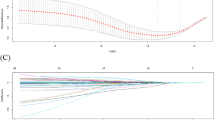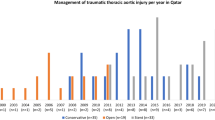Abstract
Purpose
Early identification of blunt thoracic aortic injury is vital for preventing subsequent aortic rupture. However, risk factors for blunt thoracic aortic injury remain unclear, and a prediction rule remains to be established. We developed and internally validated a new nomogram-based screening model that allows clinicians to quantify blunt thoracic aortic injury risk.
Methods
Adult patients (age ≥ 18 years) with blunt injury were selected from a nationwide Japanese database (January 2004–May 2019). Patients were randomly divided into training and test cohorts. A new nomogram-based blunt thoracic aortic injury-screening model was constructed using multivariate logistic regression analysis to quantify the association of potential predictive factors with blunt thoracic aortic injury in the training cohort.
Results
Overall, 305,141 patients (training cohort, n = 152,570; test cohort, n = 152,571) were eligible for analysis. Median patient age was 65 years, and 60.9% were men. Multivariate analysis in the training cohort revealed that 13 factors (positive association: age ≥ 55 years, male sex, high-energy impact, hypotension on hospital arrival, Glasgow Coma Scale score < 9 on hospital arrival, diaphragmatic injuries, hepatic injuries, pulmonary injuries, cardiac injuries, renal injuries, sternum fractures, multiple rib fractures, and pelvic fractures) were significantly associated with blunt thoracic aortic injury and included in the screening model. In the test cohort, the new screening model had an area under the curve of 0.87.
Conclusions
Our novel nomogram-based screening model aids in the quantitative assessment of blunt thoracic aortic injury risk. This model may improve tailored decision-making for each patient.


Similar content being viewed by others
Data availability
The authors are not authorized to distribute the dataset. Please contact the Japanese Association for the Surgery of Trauma (Trauma Registry Committee) and the Japanese Association for Acute Medicine (Committee for Clinical Care Evaluations) for data requests.
References
Neschis DG, Scalea TM, Flinn WR, Griffith BP. Blunt aortic injury. N Engl J Med. 2008;359:1708–16. https://doi.org/10.1056/NEJMra0706159.
Fox N, Schwartz D, Salazar JH, Haut ER, Dahm P, Black JH, et al. Evaluation and management of blunt traumatic aortic injury: a practice management guideline from the Eastern association for the surgery of trauma. J Trauma Acute Care Surg. 2015;78:136–46. https://doi.org/10.1097/TA.0000000000000470.
Steenburg SD, Ravenel JG, Ikonomidis JS, Schönholz C, Reeves S. Acute traumatic aortic injury: imaging evaluation and management. Radiology. 2008;248:748–62. https://doi.org/10.1148/radiol.2483071416.
Teixeira PG, Inaba K, Barmparas G, Georgiou C, Toms C, Noguchi TT, et al. Blunt thoracic aortic injuries: an autopsy study. J Trauma. 2011;70:197–202. https://doi.org/10.1097/TA.0b013e3181df68b3.
Burkhart HM, Gomez GA, Jacobson LE, Pless JE, Broadie TA. Fatal blunt aortic injuries: a review of 242 autopsy cases. J Trauma. 2001;50:113–5. https://doi.org/10.1097/00005373-200101000-00020.
Mouawad NJ, Paulisin J, Hofmeister S, Thomas MB. Blunt thoracic aortic injury—concepts and management. J Cardiothorac Surg. 2020;15:62. https://doi.org/10.1186/s13019-020-01101-6.
de Mestral C, Dueck A, Sharma SS, Haas B, Gomez D, Hsiao M, et al. Evolution of the incidence, management, and mortality of blunt thoracic aortic injury: a population-based analysis. J Am Coll Surg. 2013;216:1110–5. https://doi.org/10.1016/j.jamcollsurg.2013.01.005.
Bade-Boon J, Mathew JK, Fitzgerald MC, Mitra B. Do patients with blunt thoracic aortic injury present to hospital with unstable vital signs? a systematic review and meta-analysis. Emerg Med J. 2018;35:231–7. https://doi.org/10.1136/emermed-2017-206688.
Mosquera VX, Marini M, Muñiz J, Asorey-Veiga V, Adrio-Nazar B, Boix R, et al. Traumatic aortic injury score (TRAINS): an easy and simple score for early detection of traumatic aortic injuries in major trauma patients with associated blunt chest trauma. Intensive Care Med. 2012;38:1487–96. https://doi.org/10.1007/s00134-012-2596-y.
Kirkham JR, Blackmore CC. Screening for aortic injury with chest radiography and clinical factors. Emerg Radiol. 2007;14:211–7. https://doi.org/10.1007/s10140-007-0636-7.
Blackmore CC, Zweibel A, Mann FA. Determining risk of traumatic aortic injury: how to optimize imaging strategy. AJR Am J Roentgenol. 2000;174:343–7. https://doi.org/10.2214/ajr.174.2.1740343.
Bade-Boon J, Mathew JK, Fitzgerald MC, Mitra B. Traumatic aortic injury presenting to an adult major trauma centre. Trauma. 2019;21:272–9. https://doi.org/10.1177/1460408618773547.
Collins GS, Reitsma JB, Altman DG, Moons KGM. Transparent reporting of a multivariable prediction model for individual prognosis or diagnosis (TRIPOD): the TRIPOD statement. Ann Intern Med. 2015;162:55–63. https://doi.org/10.7326/M14-0697.
Rubin DB. Multiple imputation for nonresponse in surveys. New York: John Wiley and Sons; 1987.
Trust MD, Teixeira PGR. Blunt trauma of the aorta, current guidelines. Cardiol Clin. 2017;35:441–51. https://doi.org/10.1016/j.ccl.2017.03.010.
Dudzinski DM, Isselbacher EM. Diagnosis and management of thoracic aortic disease. Curr Cardiol Rep. 2015;17:106. https://doi.org/10.1007/s11886-015-0655-z.
Parry NG, Moffat B, Vogt K. Blunt thoracic trauma: recent advances and outstanding questions. Curr Opin Crit Care. 2015;21:544–8. https://doi.org/10.1097/MCC.0000000000000251.
Bottet B, Bouchard F, Peillon C, Baste JM. When and how should we manage thoracic aortic injuries in the modern era? Interact Cardiovasc Thorac Surg. 2016;23:970–5. https://doi.org/10.1093/icvts/ivw247.
Patel NR, Dick E, Batrick N, Jenkins M, Kashef E. Pearls and pitfalls in imaging of blunt traumatic thoracic aortic injury: a pictorial review. Br J Radiol. 2018;91:20180130. https://doi.org/10.1259/bjr.20180130.
Arthurs ZM, Starnes BW, Sohn VY, Singh N, Martin MJ, Andersen CA. Functional and survival outcomes in traumatic blunt thoracic aortic injuries: an analysis of the national trauma databank. J Vasc Surg. 2009;49:988–94. https://doi.org/10.1016/j.jvs.2008.11.052.
Dyer DS, Moore EE, Ilke DN, McIntyre RC, Bernstein SM, Durham JD, et al. Thoracic aortic injury: how predictive is mechanism and is chest computed tomography a reliable screening tool? A prospective study of 1,561 patients. J Trauma. 2000;48:673–82. https://doi.org/10.1097/00005373-200004000-00015 (discussion 682).
Demehri S, Rybicki FJ, Desjardins B, Fan CM, Flamm SD, Francois CJ, et al. ACR appropriateness criteria(®) blunt chest trauma–suspected aortic injury. Emerg Radiol. 2012;19:287–92. https://doi.org/10.1007/s10140-011-1012-1.
Funding
None.
Author information
Authors and Affiliations
Contributions
KS: conceptualized and designed the study, drafted the initial manuscript, and reviewed and revised the manuscript. HM, TI, KS, and YH: contributed to the analysis and interpretation of data, and revised the manuscript critically for important intellectual content. All the authors approved the final manuscript as submitted and agree to be accountable for all aspects of the work.
Corresponding author
Ethics declarations
Conflict of interest
The authors have no competing interests to declare that are relevant to the content of this article.
Ethical approval
This study was approved by the Institutional Review Board (approval number: 02–111). The need for informed consent was waived because the data were anonymized before analysis, and patients’ personal information were protected.
Rights and permissions
About this article
Cite this article
Shibahashi, K., Matsunaga, H., Ishida, T. et al. A new screening model for quantitative risk assessment of blunt thoracic aortic injury. Eur J Trauma Emerg Surg 48, 4607–4614 (2022). https://doi.org/10.1007/s00068-022-01925-y
Received:
Accepted:
Published:
Issue Date:
DOI: https://doi.org/10.1007/s00068-022-01925-y




